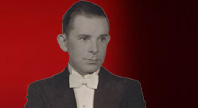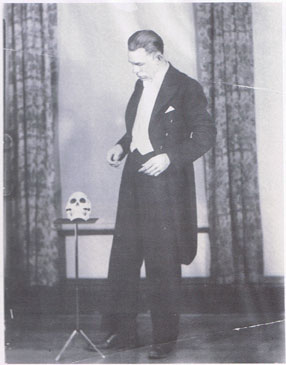
![]()
“Face-up Prediction” and
As the above statements indicate, Stewart James loved the two prediction effects he performed to dazzle the North American media in 1939; he also detested the ensuing publicity. A chapter titled “The Newspaper Headline Prediction,” in Stewart James in Print, makes clear that the then 31-year-old magician did not have any ambitions to claim supernatural powers (211). It was the combination of an overzealous promoter, Bob Weill, and an extraordinary headline on the first of September, in 1939, which thrust the hesitant magician into the spotlight. As part of a publicity stunt for a magic convention in New York, in 1938, Bob Weill told the local press that James was a renowned psychic. Despite having been forced into this role against his will, he acquiesced and agreed to predict the front-page headline for the Buffalo Evening Times one year in advance. His prediction was sealed in an envelope, locked into a chest, and sent to a police station for safekeeping. Throughout the following year, James refined methods and presentations for two of the most astounding mentalist effects ever created – the “Headline Prediction” itself and an ingenious card trick that is anything but self-working. “Face-up Prediction” was designed as a companion effect for the media circus that would surely follow the revelation of the headline once the envelope was opened in September. In many ways, this less glamorous trick discloses more about Stewart James than the newspaper stunt itself. First, it was invented using one of his unique creative strategies (the “Family Tree” brainstorming technique); second, “Face-up Prediction” establishes an intellectual link between him and another prodigious Canadian magician (Dai Vernon); third, and most importantly, this card trick falls into a completely different classification of magic and demonstrates Stewart James’ range as a creator. The opposite of a self-working magic trick is an improvisational one such as “Face-up Prediction.” The effect is basically the same as Dai Vernon’s “The Trick That Cannot Be Explained” (each was independently worked out around the same time period):
On the day of the big performance, the locked chest with James’ one-year-old prediction was dragged back out into the open, the stage was set, and the reluctant psychic was sequestered in his hotel room. Everything was arranged and proceeding according to plan. The final piece of information needed for the show was the exact wording of the Buffalo Evening Times’ headline, which Bob Weill was supposed to secretly supply to James before the show. As often happens in the performance world, something went wrong; Weill was held up and all of the newspapers were kept hidden, which, as James reflected, “even with the nicest method poses a significant problem” (SJP 212). Despite the dark cloud on the would-be-clairvoyant’s horizon, the performance went off without a hitch. The prediction pulled from the safe was nearly a word for word match; it read: “World War Threatened, Germany Attacks Poland” (emphasis added, SJP 212). Fortunately, Stewart James had heard a news broadcast on the radio in his hotel room earlier that morning. Luckier still, the most important story, the headline, was fairly easy to determine. He used the broadcast’s information to improvise and made an educated guess. The prediction was indeed successful and reporters bombarded James with questions just as he had imagined they might. He was ready and performed “Face-up Prediction” as required. However, he had not planned on predicting such a monumental world event and was overwhelmed by the publicity his performance generated. “Some of the pathetic pleas I received distressed me, knowing there was nothing I could do to help,” remembers James (SJP 213). In any case, he had never truly desired to claim supernatural abilities. After the discomforting experience, he vowed to never repeat “Headline Prediction” again. In the end, it was not the fear of unpredictable performance circumstances or the requirement of improvisation that dissuaded James from embarking upon a career as a psychic. The job description simply did not fit with his modest and more reclusive personality. That being said, Stewart James’ was about to visit Europe to play his part in the Second World War; the same war he had just predicted.
|
Copyright © 2007 Joe Culpepper and Magicana. All rights reserved.
 The details of the method employed in this trick are less important than the fact that the magician, to successfully predict the chosen card, does not rely upon mathematical principles or prepared decks. And though the performance does not require true psychic powers, it does demand a highly alert and flexible intellect. It is a coincidence that Stewart James developed this improvisational effect as a close-up trick to impress reporters during the interviews he was anticipating after September first, because he was very nearly unable to predict the Buffalo Evening Times sensational headline: “World War Threatened, Nazis Attack Poland.”
The details of the method employed in this trick are less important than the fact that the magician, to successfully predict the chosen card, does not rely upon mathematical principles or prepared decks. And though the performance does not require true psychic powers, it does demand a highly alert and flexible intellect. It is a coincidence that Stewart James developed this improvisational effect as a close-up trick to impress reporters during the interviews he was anticipating after September first, because he was very nearly unable to predict the Buffalo Evening Times sensational headline: “World War Threatened, Nazis Attack Poland.”